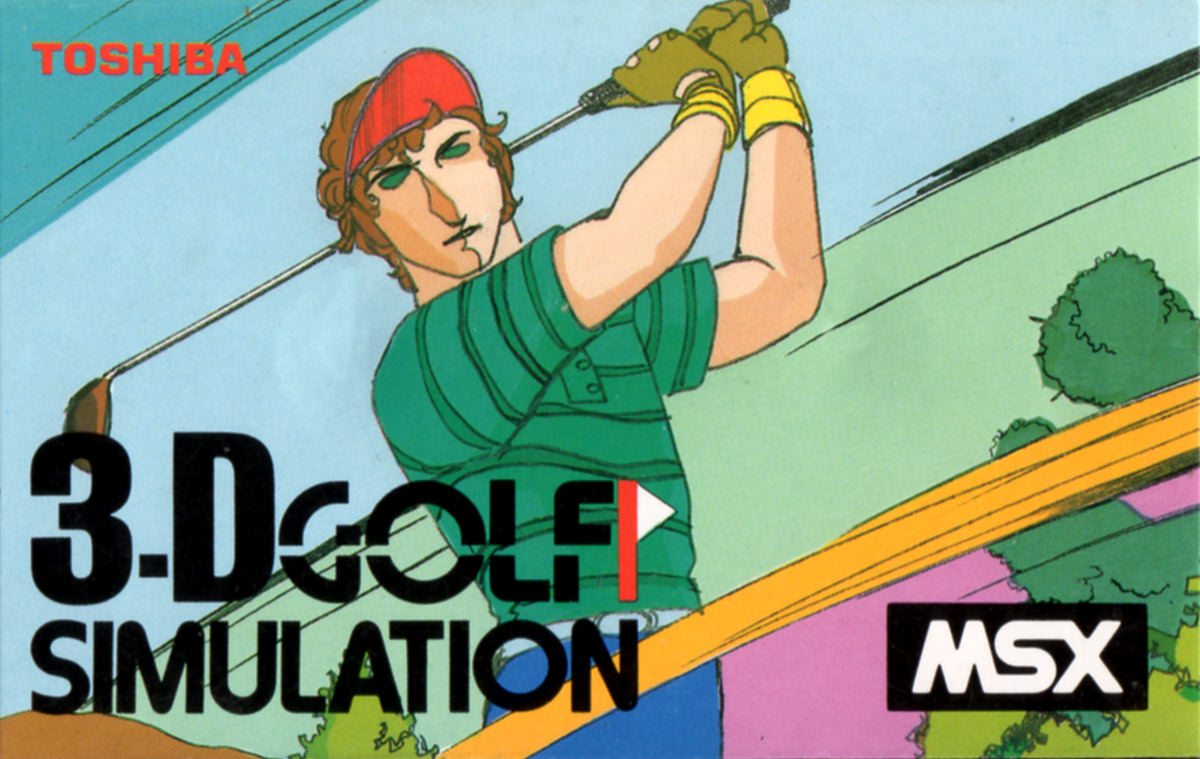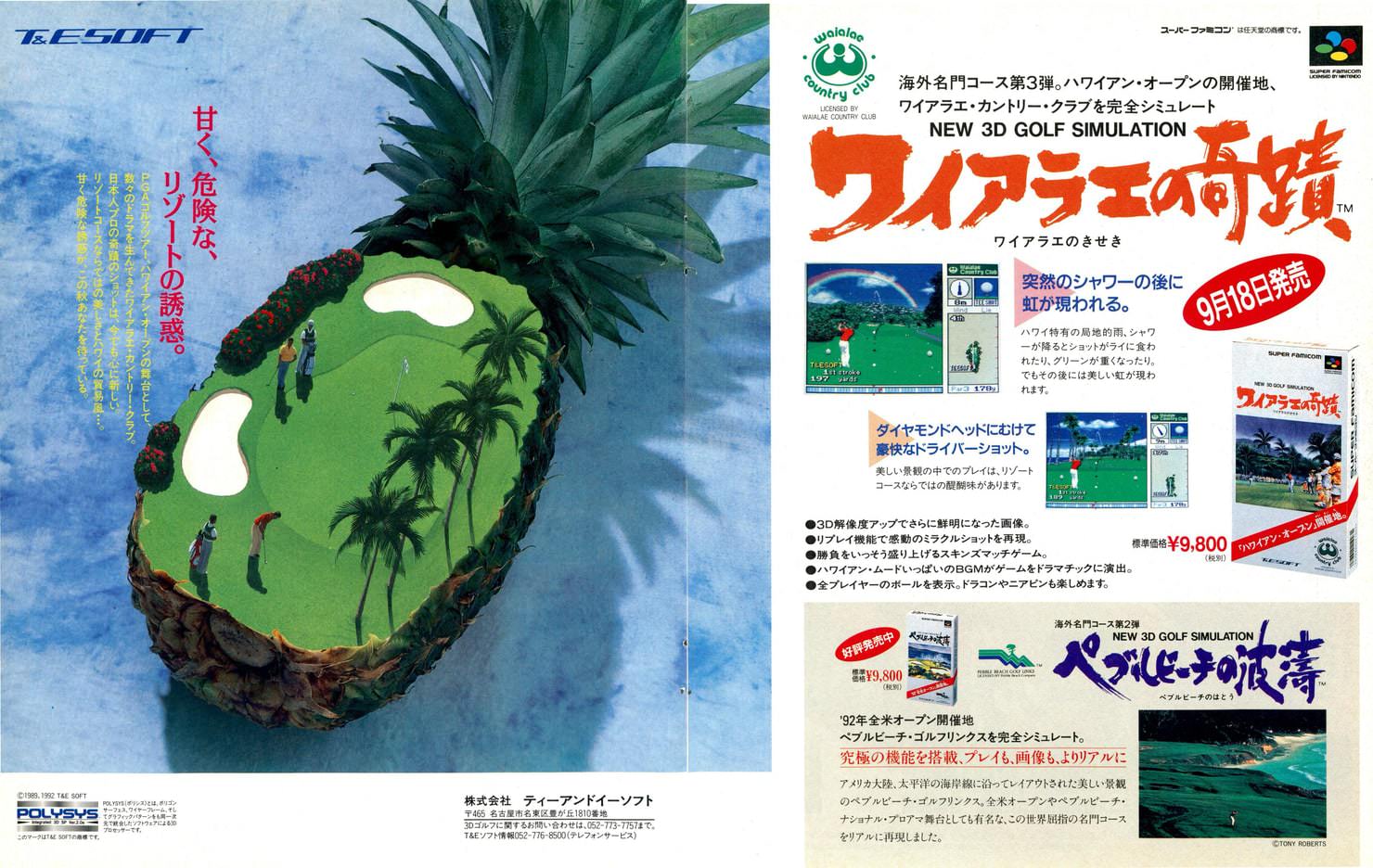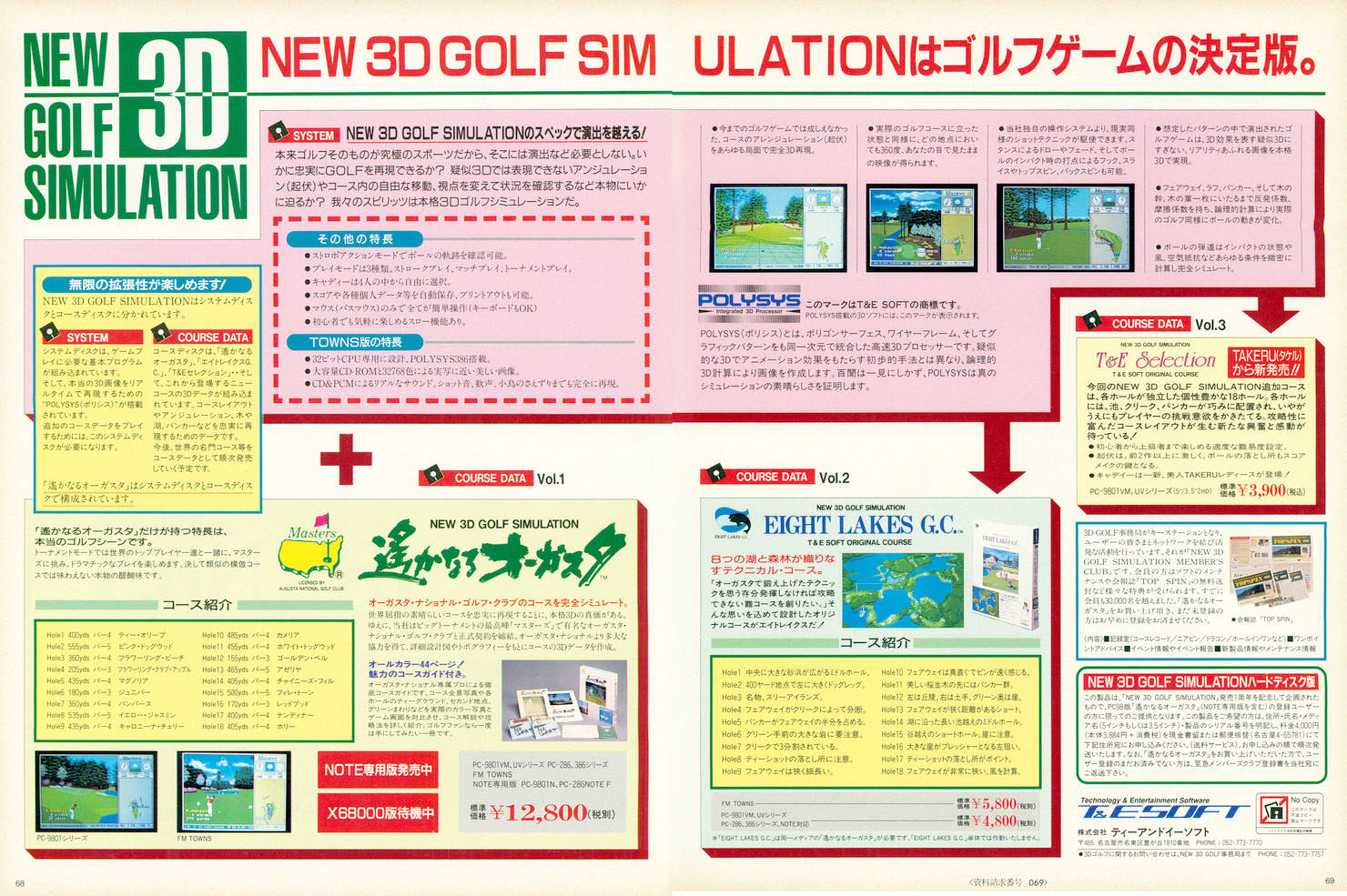Golf video games are one of my passions, ever since World Class Leader Board and Microprose Golf on Atari ST. These days my favourite golf games are still the old ones. In particular I have a soft spot for T&E SOFT’s New 3D Golf Simulation series with its blue skies, bright colours, and FM synth tunes. This series has a long history so I thought I’d do my best to recap and share some little-known knowledge.

Translation Guides
To make it easier for you to play the Japanese games mentioned below, I wrote translation guides: gamefaqs.gamespot.com/community/msephton/contributions/faqs

8-bit Computers
The series began in 1982 with リアルゴルフゲーム (Real Golf Game) for NEC PC-6001, a distinctly 2D presentation with overhead view, power bar and course map. Here’s a video of where it all began.
Things got interesting later that year with the follow-up 3Dゴルフシミュレーション (3-D Golf Simulation) which was written for the Fujitsu FM-7 computer and published in the 1983-4 issue of I/O magazine. The game was written in BASIC and its source code, including data for 18 holes known as T&E Island Golf Course, was given away in the magazine as a type-in listing. The game was released commercially on a few other Japanese 8-bit computers over the next couple of years, with machine code gradually added to speed up the 3D processing in 1984’s “High-Speed” edition for MSX and 1985’s “Super Version” for PC-6001 mkII. They’re still painfully slow.
16-bit Computers
A break of 4 years should give you some idea as to the work that was going on behind the scenes, culminating in the 1989 release of Harukanaru Augusta for PC-9801. This was an official licensed representation of Augusta National Golf Club, also known as the location of the famous Masters tournament.
This is where the series really hit its stride and made lasting impressions: high resolution graphics using a bespoke dithering system to make the most of the limited colour palette, digitised caddy images and sound effects, catchy music using FM synthesis, detailed real life golf courses, and an engaging control system. The 3DGOLF system software was upgraded a couple of times over the next few years, and a handful of add-on courses were released.

For PC-9801 the total list of available courses counted six:
-
Harukanaru Augusta (1989)
- “Distant Augusta”
- [System Disk 1.0]
-
Eight Lakes G.C. (1990)
- fictional course
-
T&E Selection (1990)
- fictional course
-
Waialae no Kiseki (1991)
- “Miracle of Waialae”
-
Pebble Beach no Hatou (1992)
- “Waves of Pebble Beach”
- [System Disk 2.0]
-
Devil’s Course (1992)
- aka Wicked 18
- fictional course
Harukanaru Augusta and Eight Lakes G.C. were also released on FM-TOWNS and Sharp X68000, but not the later courses. Maybe sales weren’t good enough? Harukanaru Augusta would also see a mail-in upgrade release as a “HD” hard disk installable version, running System Disk 2.5, but this was not backwards compatible with the previous releases. At this point the engine powering the games had been rewritten and was referred to as POLYSYS and made claims of being an “Integrated 3D Processor” or software DSP. The holes were designed in a custom CAD package. IIRC each 3D hole consisted of a mere 256 points! I need to find the cite for that.

Throughout this hugely productive Japanese PC period T&E SOFT published a printed newsletter for New 3D Golf imulation owners called “Top Spin”, which I’m yet to see a copy of. Please do get in touch if you have any information!
16-bit Consoles
The series was eventually ported to console, first to Nintendo’s Super Famicom (SNES), with Harukanaru Augusta arriving early in Japan and Waialae Country Club being a USA launch title. Later, totally different ports were released on Sega Mega Drive, which was lucky enough to get four out of the six courses. Pebble Beach was released first in the USA and later in Japan. Harukanaru Augusta, Devil’s Course and Waialae followed, but only in Japan.
These Japanese Mega Drive versions are my favourite of the bunch. They’re based on the PC-9801 games, right down to using the same course data, and the user interface is a low-resolution facsimile that retains the charm and style of the original PC interface. They really are a work of art. The Japanese versions maintain the dithering effect to show different grass types, but the USA version features only solid colours. The USA version features an easier power meter but removes the special full power shot that the Japanese version had. All in all I’d say the USA versions are easier and less attractive.
Playing them today under emulation I make sure to overclock the CPU (400% is good) to reduce the redraw times, speed up transitions, and make for an altogether more modern and enjoyable experience. You can also hold the B button to speed up ball flight animation, which is even more noticable when running overclocked. Speed runners take note!
Real 3D?
With the arrival of systems capable of real-time 3D came the opportunity for more realistic golf courses, at least. But there was some legacy baggage hanging around. The SNES was still very popular, and it wasn’t obvious how much more powerful the more awkward to program 32-bit systems like the 3DO and Saturn might be. So the final games in the series on SNES and the first in the series on 3DO and Saturn were pretty much the same: 3D but no dynamic camera. Amazing for SNES owners, and perhaps disappointing for 3DO and Saturn owners.
PlayStation and N64, on the other hand, got real 3D versions of the game. Even the Virtual Boy got a decent wireframe 3D version of this era T&E SOFT golf engine, as T&E Virtual Golf (or just Golf worldwide). Quite surprising! All are very much worth playing, though I personally favour the PlayStation games over the N64 games. Virtual Boy Golf is worth a try, just for kicks, and can be played under emulation in 3D using anaglyph red/blue glasses or in glasses-free 3D in an emulator on a Nintendo 3DS!
That said, the Saturn still had a trump up its sleeve. Perhaps because it was very popular in Japan it was the console T&E SOFT chose to release the final 32-bit version of the game, Waialae no Kiseki ~Extra 36 Holes~. As you might expect from its name there were two extra courses bundled with this game. Windy G.C. was a brand new ultra-difficult course, whilst Eight Lakes G.C. was a modernisation of the fictional course featured in the 1990 add-on disk for the original Harukanaru Augusta game for PC-98 and X68000 that released back in 1989. Full circle self-referencing from T&E SOFT—nice!
The engine also powered RPG Virtual Hydlide on SEGA Saturn.
The 19th Hole
T&E SOFT kind of ceased to exist at some point after this, though they managed to spit out a few golf games under one name or another to mixed reviews. Windows 9x got a proper version of the game in Harukanaru Augusta for Windows, which is great. PS2 got Golf Paradise (Swing Away Golf) and a Disney-branded version called Disney Golf Classic (Disney Golf) which are somewhat souless games that really don’t excite me.
The finale was somewhat of a surprise, with the DS getting Touch Golf (True Swing Golf) in 2005, and a DSi version in 2009 as A Little Bit of Nintendo Touch Golf. These are both truly great games, though if I had to choose I’d pick the DSi version as it trims some fat and focuses the game and experience perfectly: a real treat! You can read my review of the DSi verison in an older blog post.
Music
The music in this series really is some of the best FM synth you’ll hear. I can recommend this episode of the Pixelated Audio podcast to bring you up to speed.
A bunch of these games share a common music track—I call it the “T&E SOFT Golf Theme”—arranged differently to suit the host sound system capabilities.
- Waialae no Kiseki (SFC)
- Pebble Beach no Hatou (SFC)
- Harukanaru Augusta (PC-98, X68000, FMT)
Here’s a playlist of the 5 versions.
Box Art
Perhaps the box artwork is the most striking thing about the Mega Drive versions, with its classic typography-led design, strong brush-stroked calligraphic logo, and the intriguing hand-painted golf scene.
These paintings obviously represent the real life courses, but further investigation revealed that not only did they show a particular hole but they also showed a famous event that happened on the course (with the obvious exception of the fictional Devil’s Course).
I don’t have much knowledge of real life golf events but I managed to figure them out, I think, using my Google-fu. Though I’d still love to know who painted them!?
Harukanaru Augusta

Pebble Beach no Hatou

Waialae no Kiseki

Devil’s Course (Wicked 18)

Originally published: 2024-11-09
--
Buying me a coffee helps create more content like this!
--
Comments: Twitter , Bluesky , Mastodon